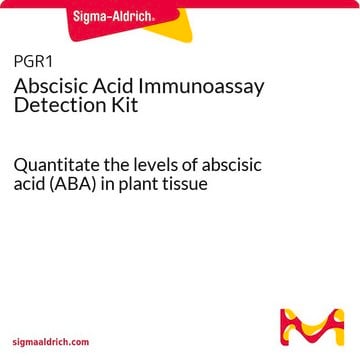Products may be shipped at a different temperature than the recommended long-term storage temperature. If the product quality is sensitive to short-term exposure to conditions other than the recommended long-term storage, it will be shipped on wet or dry-ice. If the product quality is NOT affected by short-term exposure to conditions other than the recommended long-term storage, it will be shipped at ambient temperature. As shipping routes are configured for minimum transit times, shipping at ambient temperature helps control shipping costs for our customers. For more information, please refer to the Storage and Transport Conditions document: https://www.sigmaaldrich.com/deepweb/assets/sigmaaldrich/marketing/global/documents/316/622/storage-transport-conditions-mk.pdf
862169
2-cis,4-trans-Abscisic acid
synthetic, 98%
Sinonimo/i:
(±)-Abscisic acid, (2Z,4E)-5-(1-Hydroxy-2,6,6-trimethyl-4-oxo-2-cyclohexen-1-yl)-3-methyl-2,4-pentadienoic acid, ABA, Dormin
About This Item
Prodotti consigliati
Livello qualitativo
Saggio
98%
Stato
powder
Punto di fusione
186-188 °C (lit.)
Gruppo funzionale
carboxylic acid
hydroxyl
ketone
Temperatura di conservazione
2-8°C
Stringa SMILE
CC(\C=C\C1(O)C(C)=CC(=O)CC1(C)C)=C\C(O)=O
InChI
1S/C15H20O4/c1-10(7-13(17)18)5-6-15(19)11(2)8-12(16)9-14(15,3)4/h5-8,19H,9H2,1-4H3,(H,17,18)/b6-5+,10-7-
JLIDBLDQVAYHNE-LXGGSRJLSA-N
Cerchi prodotti simili? Visita Guida al confronto tra prodotti
Categorie correlate
Descrizione generale
Applicazioni
- Chiral Separation of Abscisic Acid: Research demonstrated direct chiral separation of abscisic acid using high-performance liquid chromatography with a phenyl column and a gamma-cyclodextrin mobile phase, advancing the analytical methods essential for studying plant stress hormones (Terashima et al., 2023).
- Xanthine Oxidase Inhibitory Activity: A study including abscisic acid derivatives showed significant xanthine oxidase inhibitory activity, offering potential health benefits and therapeutic applications (Miyata et al., 2019).
- Anticancer Potential: Extracts containing abscisic acid from mangrove endophytic fungi exhibited cytotoxic properties and induced G(0)/G(1) cell cycle arrest and apoptosis in human cancer cells, highlighting their potential in cancer treatment strategies (Zhou et al., 2018).
- Antidiabetic Activity: Extracts involving abscisic acid from an endophytic fungus showed promising antidiabetic activity, potentially improving treatment options for diabetes through natural product research (Uzor et al., 2017).
- Glucose Tolerance and Insulinemia Reduction: A groundbreaking study found that microgram amounts of abscisic acid in fruit extracts significantly improve glucose tolerance and reduce insulin levels in rats and humans, suggesting its use as a dietary supplement for managing diabetes (Magnone et al., 2015).
Codice della classe di stoccaggio
11 - Combustible Solids
Classe di pericolosità dell'acqua (WGK)
WGK 3
Punto d’infiammabilità (°F)
Not applicable
Punto d’infiammabilità (°C)
Not applicable
Dispositivi di protezione individuale
Eyeshields, Gloves, type N95 (US)
Scegli una delle versioni più recenti:
Possiedi già questo prodotto?
I documenti relativi ai prodotti acquistati recentemente sono disponibili nell’Archivio dei documenti.
I clienti hanno visto anche
-
How is shipping temperature determined? And how is it related to the product storage temperature?
1 answer-
Helpful?
-
-
How can I determine the shelf life / expiration / retest date of this product?
1 answer-
If this product has an expiration or retest date, it will be shown on the Certificate of Analysis (COA, CofA). If there is no retest or expiration date listed on the product's COA, we do not have suitable stability data to determine a shelf life. For these products, the only date on the COA will be the release date; a retest, expiration, or use-by-date will not be displayed.
For all products, we recommend handling per defined conditions as printed in our product literature and website product descriptions. We recommend that products should be routinely inspected by customers to ensure they perform as expected.
For products without retest or expiration dates, our standard warranty of 1 year from the date of shipment is applicable.
For more information, please refer to the Product Dating Information document: https://www.sigmaaldrich.com/deepweb/assets/sigmaaldrich/marketing/global/documents/449/386/product-dating-information-mk.pdfHelpful?
-
Active Filters
Il team dei nostri ricercatori vanta grande esperienza in tutte le aree della ricerca quali Life Science, scienza dei materiali, sintesi chimica, cromatografia, discipline analitiche, ecc..
Contatta l'Assistenza Tecnica.







